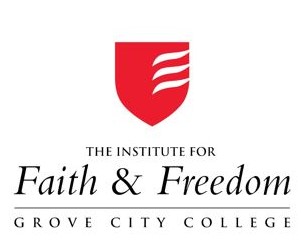When Providence is More Plausible: A Sign on the Mountainside

From the earliest days of colonial settlement, Americans searched for signs that heaven smiled on their endeavors and for most of their history they found such portents everywhere.
The evidence of fateful favoritism seemed so overwhelming, so undeniable, that for more than three centuries even cynics and outsiders acknowledged it with a shrug. Shortly before his death in 1898, the former German Chancellor Otto von Bismarck reputedly declared his belief in a “special Providence that protects imbeciles, infants, drunkards and the United States of America.” Eighty years earlier, his countryman, the great poet Johann Wolfgang von Goethe, penned a memorable lyric on the theme, “America, you have it better.” He discerned a special blessing in the absence of “fallen-down castles” and “useless memories” to disturb the “lively present” of the rising power in the New World. Sympathetic observers noted that nature herself had pre-ordained the nation for world-changing greatness. In 1835, French visitor Alexis de Tocqueville said of the Americans: “Their ancestors gave them the love of equality and freedom, but God himself gave them the means of remaining equal and free, by placing them upon a boundless continent which is open to their exertions.”
In a remote and inaccessible corner of that “boundless continent,” an eager populace, exhausted from four years of Civil War slaughter, found a spectacular symbol that offered reassuring proof of divine entanglement in American affairs. In 1868, an ardent abolitionist editor from Massachusetts sought to renew his failing health with a long-exploring expedition to the uncharted territory of the Colorado Rockies. There, Samuel Bowles heard mysterious rumors of an “immense cross” formed from melting snow that appeared every year on the sheer rock face of a towering wilderness peak. Blazing a painstaking trail to a view ledge near the top of Gray’s peak, the Bowles party stared in wonder at a miraculous sight some forty miles away. Across a thickly forested valley, looming above the pristine lake later known as “The Bowl of Tears,” they saw the huge, near perfect cross, glistening in the summer sun. Formed by the winter snow lodged within a deep rock gully more than 1,500 feet high, then intersected by a horizontal line of frozen, purest white along a 750 foot shelf, the otherworldly vision produced tears and exaltation from the breathless travelers. In his subsequent book, The Switzerland of America, Samuel Bowles declared: “It is as if God has set His sign, His seal, His promise there- a beacon upon the very center and height of the Continent to all its people and all its generations.”
Inspired by reports of this wonder of nature, Civil War veteran Ferdinand Hayden led an expedition for the U.S. Geological Survey in the summer of 1873, accompanied by some-time painter, missionary to the Indians and pioneer photographer William Henry Jackson, in hopes of finding and documenting the elusive “Mountain of the Holy Cross.” After several wrong turns and dead ends, the group headed north from Twin Lakes, across the Tennessee Pass and Eagle River and, after two exhausting days of climbing, they finally reached the shoulder of Notch Mountain. Jackson led the way, though he struggled with his heavy, bulky camera equipment to climb out of the enclosing forest. He recalled years later: “I emerged above the timberline, and the clouds, and suddenly, as I clambered over a vast mass of jagged rocks, I discovered the great shining cross, there before me, tilted against the mountainside.”
He called to his breathless colleagues and at the very moment that they gazed together at the legendary vision, a glorious rainbow suddenly, miraculously appeared, in a “sublime and sacred moment” that moved even F.V. Hayden, a notorious unbeliever. Jackson’s stunning photographs, completed over the next two days, provided powerful proof of the miraculous arrangement of rock and snow. Formally presented to the House Committee on Appropriations and ultimately to President Ulysses S. Grant himself, the pictures received wide distribution and caused a national sensation.
Among those directly inspired by the images from the Rockies was the lavishly talented landscape painter Thomas Moran, already celebrated for his breathtaking canvasses of the new national park at Yellowstone. He determined to accompany Hayden on his next Colorado trip with the specific purpose of painting the celebrated “Cross of Snow.” The gigantic masterpiece that resulted, measuring seven feet by five feet, became a wildly popular attraction at the Philadelphia Centennial International Exposition of 1876, displayed to overwhelming acclaim together with W. H. Jackson’s starkly beautiful black-and-white photographs. The excitement regarding these images related in part to the fateful change in Colorado’s status, with the distant and sparsely settled territory winning admission to the union on August 1st, at the height of the Centennial celebrations. In catalogue material for the world’s fair, Moran encouraged this sense of destiny and baldly declared: “The Mountain of the Holy Cross is in some respects the most remarkable peak on the American continent.” A New York reviewer, overwhelmed by the painting’s grandeur, meaning and spiritual power, rapturously concluded: “Beyond a question, in the painting of this picture, Mr. Thomas Moran has made one of those exceptional leaps which bridge the chasm between reputation and immortality.”
More than 60 years after its creation, this “immortal” image found its way to a place of honor in the mansion home of one of its countless admirers: the singing cowboy and Hollywood mogul Gene Autry, who later made it part of the permanent collection of his Autry Museum of Western Heritage. By that time, the view of the mountain with the monumental symbol seared upon its side had become so much a feature of popular culture that the beloved poet Henry Wadsworth Longfellow invoked it as a title of a moving sonnet, “The Cross of Snow,” comparing the shimmering image that re-appeared every summer in wild and lonely Colorado with his “changeless” mourning for his long-dead wife. He wrote:
There is a mountain in the distant West
That, sun-defying, in its deep ravines
Displays a cross of snow upon its side.
For those unsatisfied with the vicarious experience of contemplating poetic, painterly or photographic images of the grand symbol, pilgrimages began as railroad service improved. In 1930 the Denver Post reported: “There is an unusual number of persons this year who are afflicted with serious maladies that have defied the best efforts of medical science: they hope that sight of the Holy Cross, coupled with firm faith in divine power, will accomplish cures. Certainly such cures have resulted from the pilgrimages of the last two years.” Some of the fervent believers who made their way into the mountains attested to the mystical power of the “holy water” produced by run-off from the melting snow wedged within the seams that produced the cross.
By 1929, interest in the site had developed so strongly that President Herbert Hoover declared it a National Monument, despite the inaccessibility of the rugged location. Five years later, FDR’s Civilian Conservation Corps built a log lodge to accommodate the miracle-seeking pilgrims. During the war, however, interest fell off sharply, in part due to rockslides and erosion that marred the right arm of the cross and spoiled its previously symmetrical perfection. Because of the thick blanket of snow that covers the mountainside for most of each year until the thaw of early summer, no one could determine with any precision when and how the damage occurred, but the best guess was that the cross fell during the early ‘40’s, at the same time that millions of Americans fought and died in bloody overseas battles.
Ironically, in 1951, the postal service issued a commemorative stamp to honor the 75th anniversary of Colorado statehood, featuring three icons of the Mountain State: the Columbine flower, the state capitol building, and the Mountain of the Holy Cross – in an antique image that ignored the recent damage. Despite this philatelic tribute, the National Park Service couldn’t ignore the declining interest in the cross of snow and stripped the site of its National Monument status in a cost-cutting move in 1950.
Few have protested this downgrade in all of the intervening years: after all, recent trends have seen far more energy expended in protesting crosses on public land than on consecrating them. Though no one suspects human agency or interference in either creating or marring the religious imagery seemingly inscribed by a giant, unseen hand on the craggy flank of a peak more than 14,000 feet above sea level, there’s a hint of embarrassment about ascribing deeper significance to the curious formation in the Rockies. The frequent stories about impressionable observers identifying the face of Christ in window smudges or on freshly baked croissants makes it easy to forget that distinguished American artists like Thomas Moran, Henry Wadsworth Longfellow and W.H. Jackson felt no hesitation at all in identifying the cliffside marking as an unmistakable cross that compelled an appropriately reverent response.
Moderns may snicker at the nineteenth-century eagerness to embrace a grand design on a mountainside as indication of still grander designs by which God placed “His sign, His seal, His promise” upon the continent. But dismissal of the old faith in Providence and its protections leads inevitably to guilty conclusions about America’s rise to power and prosperity that count as less rational than traditional assumptions of divine favor. No one can challenge the basic premise of American Exceptionalism: that the United States counts as a unique nation of unprecedented origins and incomparable impact. But it matters a great deal whether the world sees America as exceptionally good or exceptionally awful.
Explorers and artists once marveled at a huge and unmistakable symbol that looked as if nature itself tried to send them a message. Why is it inherently more rational to see this remarkable manifestation as a meaningless coincidence rather than a significant signal?
This column originally appeared on TruthRevolt.org on June 30, 2014.





















